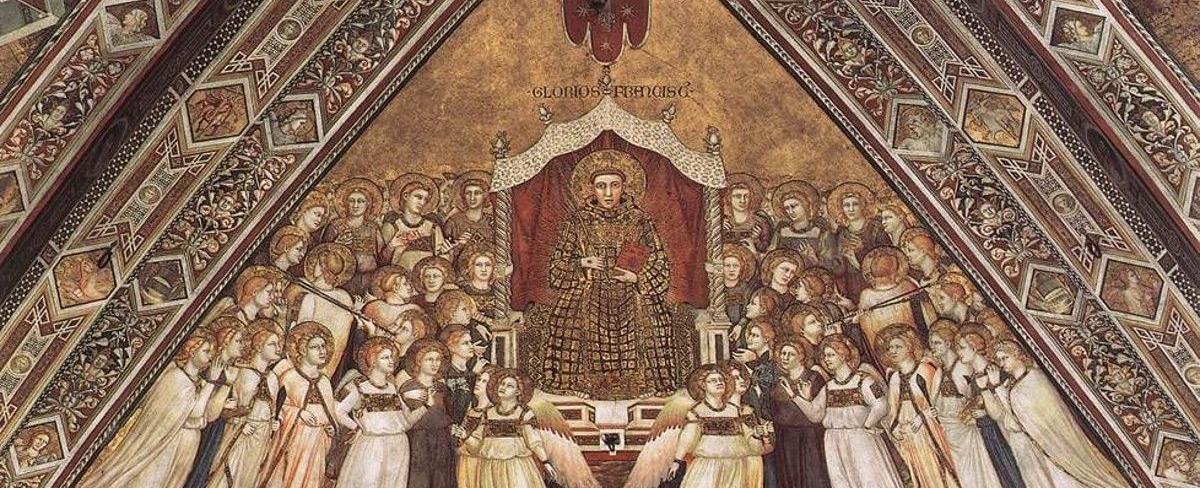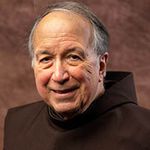Saint Francis: The “Poor Man of Assisi”

"Alleluia, Alleluia, Francis,
poor and humble, enters heaven rich
and is welcomed with celestial hymns. Alleluia."
Around the world people celebrate Francis
On October 4, Franciscan men and women, with all Christians, many religious people of other faiths, and countless people of goodwill throughout the world honor the inspiring memory of Francis of Assisi, “the Poverello.”
 Saint Francis desired to follow Christ in his self-emptying and so “weds” Lady Poverty. Detail from fresco in the lower basilica of San Francesco in Assisi (Giotto, c. 1320).
Saint Francis desired to follow Christ in his self-emptying and so “weds” Lady Poverty. Detail from fresco in the lower basilica of San Francesco in Assisi (Giotto, c. 1320).
Francis renounced wealth, status
Francis died on this date in 1226, as his first biographer tells us, “having completed twenty years since his conversion,” when he renounced wealth and status before the bishop of Assisi to follow the poor and humble Christ. The chief highlights of his life, as well as some of his more important writings and prayers are available at https://ofm.org/about/st-francis/ (scroll down to see the timeline).
Francis exercises a real fascination on people
We must recognize that the spiritual families that have claimed Francis have sometimes been content to repeat formulas that have lost all concrete meaning, whereas authentic fidelity consists in creating a now. The Poor Man of Assisi was the protagonist of a story which probably could not have succeeded to take shape and be perpetuated in the context of the Church and society of its own time. . .But it is in the measure that his message contains within it numerous possibilities which could not be realized in the past that it conserves a real “force of contemporaneousness” and that it still interests us today. Francis has not been the only true Christian that history has ever known, or even perhaps the most perfect. But he has not ceased, since the thirteenth century, to exercise a real fascination on people. And he constitutes even today a figure to whom individuals and societies look to compare themselves in order to find in him, to use the Gospel term, nova et vetera: old truths and new ideas (Andre Vauchez, Francis of Assisi: The Life and Afterlife of a Medieval Saint, 2012).
Key insights about Francis’s spirituality
Richard Rohr, OFM, offers a nice reflection today on a key insight of Francis’s spirituality: https://cac.org/seeing-things-as-they-truly-are-2021-10-04/.
![]() 802 years ago this month, Francis crossed the battle lines during the Crusades to speak personally with the Muslim leader, the Sultan of Egypt, al-Malik al-Kamil. Instead of perpetuating violence, the two men parted in mutual respect. Detail from icon of Francis embracing the Sultan of Egypt, al-Malik al-Kamil, by Robert Lentz, OFM.
802 years ago this month, Francis crossed the battle lines during the Crusades to speak personally with the Muslim leader, the Sultan of Egypt, al-Malik al-Kamil. Instead of perpetuating violence, the two men parted in mutual respect. Detail from icon of Francis embracing the Sultan of Egypt, al-Malik al-Kamil, by Robert Lentz, OFM.
Read Francis’s writings, medieval sources about him
All of Francis's writings as well as all the early medieval sources about him and the early Franciscan movement are available on our website: https://www.franciscantradition.org.
 The tomb of Saint Francis in the crypt chapel, San Francesco, Assisi, where countless pilgrims come to pray.
The tomb of Saint Francis in the crypt chapel, San Francesco, Assisi, where countless pilgrims come to pray.
May Francis continue to inspire—and challenge—us!
-----
Main image: Saint Francis, in heavenly glory—fresco on the ceiling of the lower basilica of San Francesco, Assisi (Giotto, c. 1320). Francis is depicted wearing the vestments of a deacon. Seeing this depiction, one immediately thinks of the Gregorian chant antiphon mentioned at the beginning of this post.
Dominic Monti, OFM
Professor of Franciscan Research in the Franciscan Institute of St. Bonaventure University
Dominic V. Monti, OFM, is a Franciscan Friar of Holy Name Province (USA) and currently professor of Franciscan Research in the Franciscan Institute of St. Bonaventure University. He devoted the greater part of his ministry to teaching the History of Christianity, in particular the history of the Franciscan movement. He has contributed two volumes to the Works of St. Bonaventure series and is author of Francis & His Brothers, a popular history of the Friars Minor.

